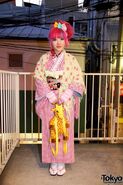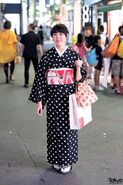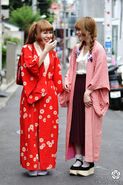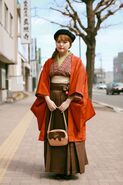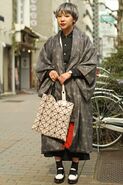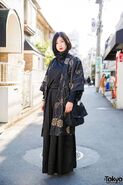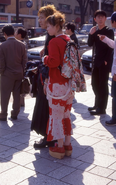Kimono style is a broad term to describe any style that incorporates the use of the traditional Japanese garment, the kimono. The style has no hard and fast rules, and will vary widely from person to person.
The term may include those that wear clothing that is in the traditional fashion exactly. However, it may also include modern street fashion interpretations of the kimono, yukata, or various other kimono-related items, such as using traditional kimono prints as fabric for other clothing.
The Name[]
The kimono (着物, きもの) is a traditional Japanese garment that has been worn in Japan in some form since the late 700s, AD. The word kimono literally translates to "a thing to wear on the shoulders." The word ki in kimono also comes from the verb kiru (着る), meaning to wear. [1]
Kimono is a gender-neutral term, and it applies to the traditional clothing of both men and women in Japan.
History of the Kimono[]
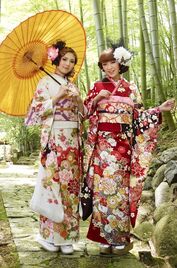
Modern Traditional Kimonos
Kimono styled clothing is believed to have evolved slowly from Chinese fashions until it became a distinctly Japanese style of its own somewhere around the late 700s, AD. It generally describes all traditional Japanese clothing, however, in foreign cultures, it has come to describe the particular women's fashion of kimono.

Kimono fashion in Japanese historical artwork
Although kimono was once daily wear, with the rise of modernization in the early 1900s, it gradually fell out of common use. Today, kimono is mostly worn on special occasions, such as weddings, tea ceremonies, coming of age ceremonies, and other very special holidays and occasions.
There are some groups that still wear kimono as daily wear, which tend to be older generations, geisha, and sumo wrestlers. [1]
Style Basics[]
Kimono style may refer to modern or traditional interpretations of the style.
Traditional Fashion[]
Traditionally the kimono has come to be a T-shaped wrapped garment with various sleeve lengths based on age, gender, and status. The kimono is usually with an ankle-length hem, with the collar always worn left over right, with the opposite being reserved for the deceased. The kimono is tied with a sash called an obi, which is knotted at the back of the garment. Traditional kimono are generally worn along with traditional footwear such as zōri or geta, and split-toed socks called tabi. [1]
Modern Fashion[]
Modern interpretations of kimono style are much less strict in rules and much vaguer. The only single qualification is that it incorporates some aspect of traditional kimono style garments. Simply using a geta or tabi will not qualify, as it specifically refers to the kimono itself. However, outside of that rule, outfits can vary wildly. For instance, some may choose to wear a traditional kimono in a traditional way, only adding modern accessories, or modern prints and color schemes. Others may wear the kimono open and untied, or shorter than normal. Modern interpretations may also use other traditional Japanese garments like the yukata and hakama in their interpretations. [2]
Brands & Shops[]
There are no brands associated with the kimono style. Any brand or shop that sells kimono would qualify as acceptable for the style.
Gallery[]
External Links[]
- ↑ 1.0 1.1 1.2 "Kimono." Wikipedia. August 24, 2020. Retrieved August 26, 2020 from https://en.wikipedia.org/wiki/Kimono
- ↑ "On the Street....Aoyama, Tokio." The Sartorialist. August 31, 2011. Retrieved August 26, 2020 from https://web.archive.org/web/20190526195911/https://www.thesartorialist.com/photos/on-the-street-aoyama-tokio-6/

